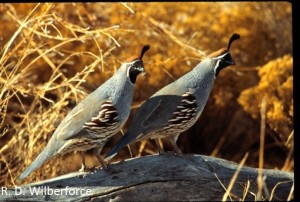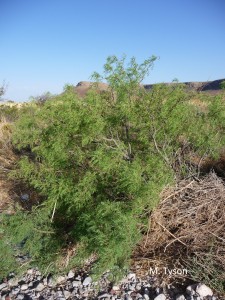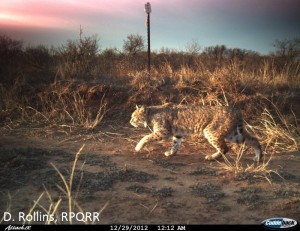The Gambel’s Quail (Callipepla gambelii) is one of the four species of quail that reside in the state. They are named after American naturalist William Gambel and are commonly found near sources of water in far west Texas, notably the Trans-Pecos ecoregion.
Vocalizations
The Gambel’s Quail has many different vocalizations for different circumstances. Their most notable call is a loud three note “ka-KAA-ka” and is used as an assembly call or to locate other quail in the area. Kow ”and“ whit whit calls are used by courting males to attract females. They also are known to use various clucking noises and grunts to communicate between individuals. An alarming “chip-chip-chip” is issued to the covey when danger is near.
Physical Attributes
Gambel’s Quail can be easily identified, when compared to the other Texas quail species, by a prominent teardrop-shaped, black plume on their heads. Both male and female Gambel’s quail have gray breasts and upperparts with white-streaked, chestnut sides. Males can be identified by their black face and forehead and rusty crown bordered by a white line at its base. Males also have a black inner patch on their underside which differentiates them from females. The female Gambel’s quail lack the distinctive facial features of the male and have a smaller, less prominent plume. Being slightly larger than Northern Bobwhites, Gambel’s quail are just under a foot long with an average wingspan of 15 inches. Similar to other Texas quail, Gambel’s prefer to run and hide when flushed, rather than fly.
Nesting and Incubation
Because they live in the harsher desert regions, Gambel’s breeding patterns are impacted by the amount of green vegetation available to eat. Research suggests that they react positively to higher rainfall levels and cooler temperatures in terms of breeding productivity. Gambel’s quail are thought to be a monogamous species meaning that they keep the same mate throughout their lives. Nesting is thought to take place on the ground near shrubs or prickly pear cactus by forming a slight depression in the ground. This protects against predators but also provides a shade from the desert sun. The female normally lays 10-14 creamy colored eggs over a period of 30 days or more. These spotted eggs offer their own form of camouflage against nest predators. Hatching begins between March and April. Once hatched, the chicks are precocial, meaning they are capable of moving about the nest, but they rely on adults until about three months of age. Typically, by late August, adults and their young form into distinct coveys, ranging in size from one to two dozen individuals. These coveys tend to congregate throughout the winter months and then disperse again towards the end of the cold season.
Habitat and Diet
The Gambel’s Quail is a resident of the extreme western part of the Trans-Pecos region but are more common in New Mexico and Arizona. Woody thickets surrounding riparian areas are a favorite of this species, as well as desert scrublands, canyons and brushy open country. Woody vegetation, such as tarbush, Apache plume and little leaf sumac, are important for their survival and are used not only for cover but for food and roosts. Water is not thought to be a major factor in the survival of Gambel’s quail as foods consumed seem to meet their daily needs. Most of this water is from metabolic and preformed sources, but over the hotter summer months they incorporate the use of surface water as well.
Because they live in more arid regions, Gambel’s survive on a very diverse but limited supply of food. This species of quail often feeds near the ground for buds, seeds, tender shoots, insects, fruit, cacti, nuts and leaves. Varying precipitation each year force the Gambel’s quail to seek less herbaceous plants and more fruit and berries from shrubs and cactus. Seeds from mesquite and acacia combined with other plants such as Texas bindweed can make up a large portion of their diet in some years. Plants including vines or sumac and even insects, such as ants, spiders and beetles, complete their diets. Gambel’s have adapted to the severe west Texas climate, during the hot summer months, Gambel’s are thought to mainly feed in the early morning and late evening hours.
Predation and Other Mortality Factors
Predators of Gambel’s include hawks and bobcats, while nest predation from skunks, coyotes, snakes and ground squirrels also lowers populations. More studies on this quail species are needed for a better understanding of their population dynamics and mortality factors in Texas.
Conservation and Management
Having ample amounts of suitable habitat will help to positively influence Gambel’s quail populations. It is thought that Gambel’s prefer a woodier, vegetation-rich habitat, thus landowners are encouraged to focus their land management efforts to provide a diversity of foods and ample woody cover especially within and around riparian areas. Keeping Gambel’s quail in mind when making management decisions that could affect their habitat today could help preserve this species for years to come.
Citations:
Kuvlesky, William P. Jr., Stephen J. De Maso, and Michael D. Hobson. 2007. Gambel’s Quail Ecology and Life History. Pages 6-22 in Leonard A. Brennan, editor, Texas Quails: Ecology and Management. College Station: Texas A&M University Press.
Sauer, J. R., J. E. Hines, J. E. Fallon, K. L. Pardieck, D. J. Ziolkowski, Jr., and W. A. Link. 2012. The North American Breeding Bird Survey, Results and Analysis 1966 – 2011. Version 07.03.2013 USGS Patuxent Wildlife Research Center, Laurel, MD
ML Audio 118607. Gambel’s Quail – Callipepla gambelii. Geoffrey A. Keller. United States, Arizona, Organ Pipe Cactus National Monument. 12 April 2001. Macaulay Library, www.macaulaylibrary.org. Cornell Lab of Ornithology.


